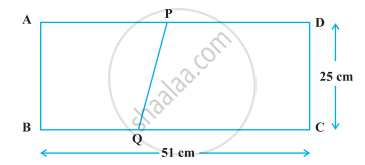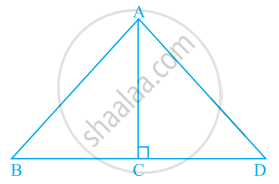Advertisements
Advertisements
प्रश्न
The area of a triangle with vertices A, B, C is given by ______.
विकल्प
`|vec("AB") xx vec("AC")|`
`1/2|vec("AB") xx vec("AC")|`
`1/4|vec("AC") xx vec("AB")|`
`1/8|vec("AC") xx vec("AB")|`
उत्तर
The area of a triangle with vertices A, B, C is given by `underline(bb(1/2|vec(AB) xx vec(AC)|))`.
Explanation:
The area of the parallelogram with adjacent sides AB and AC = `|vec("AB") xx vec("AC")|`. Hence, the area of the triangle with vertices A, B, C = `1/2|vec("AB") xx vec("AC")|`
APPEARS IN
संबंधित प्रश्न
The perimeter of a right triangle is 60 cm. Its hypotenuse is 25 cm. Find the area of the triangle.
If P(–5, –3), Q(–4, –6), R(2, –3) and S(1, 2) are the vertices of a quadrilateral PQRS, find its area.
Prove that the points (a, b + c), (b, c + a) and (c, a + b) are collinear
median of a triangle divides it into two triangles of equal areas. Verify this result for ΔABC whose vertices are A (4, - 6), B (3, - 2) and C (5, 2).
Find the centre of a circle passing through the points (6, − 6), (3, − 7) and (3, 3).
The vertices of a ΔABC are A (4, 6), B (1, 5) and C (7, 2). A line is drawn to intersect sides AB and AC at D and E respectively, such that `(AD)/(AB) = (AE)/(AC) = 1/4`Calculate the area of the ΔADE and compare it with the area of ΔABC. (Recall Converse of basic proportionality theorem and Theorem 6.6 related to ratio of areas of two similar triangles)
Show that points A (a, b + c), B (b, c + a), C (c, a + b) are collinear.
The area of a triangle is 5 sq units. Two of its vertices are (2, 1) and (3, –2). If the third vertex is (`7/2`, y). Find the value of y
Find the missing value:
| Base | Height | Area of triangle |
| 15 cm | ______ | 87 cm2 |
Prove that the points (2,3), (-4, -6) and (1, 3/2) do not form a triangle.
Two vertices of a triangle are (1, 2), (3, 5) and its centroid is at the origin. Find the coordinates of the third vertex.
If A(5,2), B(2, -2) and C(-2, t) are the vertices of a right triangle with ∠B=90° , then find the value of t .
Show that the points A(-5,6), B(3,0) and C(9,8) are the vertices of an isosceles right-angled triangle. Calculate its area.
Find the value of x for which points A(x, 2), B(-3, -4) and C(7, -5) are collinear.
Find a relation between x and y, if the points A(2, 1), B(x, y) and C(7,5) are collinear.
Prove that the points A (a,0), B( 0,b) and C (1,1) are collinear, if `( 1/a+1/b) =1`.
The coordinates of the point P dividing the line segment joining the points A (1, 3) and B (4, 6) in the ratio 2 : 1 are:
Find the value(s) of k so that the quadratic equation x2 − 4kx + k = 0 has equal roots.
Using integration, find the area of triangle ABC, whose vertices are A(2, 5), B(4, 7) and C(6, 2).
Show that the ∆ABC is an isosceles triangle if the determinant
Δ = `[(1, 1, 1),(1 + cos"A", 1 + cos"B", 1 + cos"C"),(cos^2"A" + cos"A", cos^2"B" + cos"B", cos^2"C" + cos"C")]` = 0
The area of a triangle with vertices (–3, 0), (3, 0) and (0, k) is 9 sq.units. The value of k will be ______.
If the points (3, -2), (x, 2), (8, 8) are collinear, then find the value of x.
The area of a triangle with vertices A(3, 0), B(7, 0) and C(8, 4) is ______.
Find the values of k if the points A(k + 1, 2k), B(3k, 2k + 3) and C(5k – 1, 5k) are collinear.
The dimensions of a rectangle ABCD are 51 cm × 25 cm. A trapezium PQCD with its parallel sides QC and PD in the ratio 9 : 8, is cut off from the rectangle as shown in the following figure. If the area of the trapezium PQCD is `5/6` th part of the area of the rectangle, find the lengths QC and PD.

In the given figure, ratio of the area of triangle ABC to the area of triangle ACD is the same as the ratio of base BC of triangle ABC to the base CD of ΔACD.

Find the missing value:
| Base | Height | Area of Triangle |
| ______ | 31.4 mm | 1256 mm2 |
